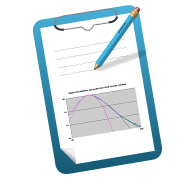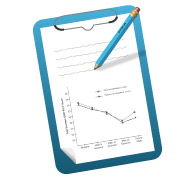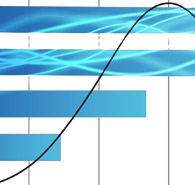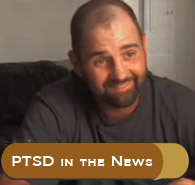Archive for the ‘Application of Neurofeedback’ Category
Wednesday, March 5th, 2014
by Siegfried Othmer, PhD
 I n the previous newsletter it was established that the outliers in the distribution of reaction times could not be interpreted as the tail of the Gaussian distribution. They had to be treated as a distinct phenomenon. When it came to characterizing the distribution function that characterizes the outliers, the analysis suffered from insufficient data. After all, reaction time outliers are relatively rare, so even a database of over 1500 did not give us enough to work with. I n the previous newsletter it was established that the outliers in the distribution of reaction times could not be interpreted as the tail of the Gaussian distribution. They had to be treated as a distinct phenomenon. When it came to characterizing the distribution function that characterizes the outliers, the analysis suffered from insufficient data. After all, reaction time outliers are relatively rare, so even a database of over 1500 did not give us enough to work with.
(more…)
Posted in ADD / ADHD, Application of Neurofeedback, Neurofeedback | No Comments »
Wednesday, March 5th, 2014
by Siegfried Othmer, PhD
 A research group in the Netherlands has recently published two neurofeedback studies that failed to corroborate the claims for EEG-informed “Theta/beta” neurofeedback in application to ADHD. The first one of these of which I became aware had relied on parent and teacher ratings to establish progress (van Dongen-Boomsma et al., 2013). Such a study is easy to critique. After all, we have learned not to rely too much on parental observations on their ADHD children in our work. Is that really the best that can be done in the context of a carefully done study? Why not rely on some hard data from neuropsychological testing, for example? Well, it turns out that that was done also, and that was reported in the second paper (Vollebregt et al., 2013). Therein lay the answer that would be much more definitive. Alas, the outcomes were not favorable either. The experimental group did not distinguish itself from the control group in any meaningful way on any of the chosen tests. The tests had been selected with specific characteristics of ADHD in mind. A research group in the Netherlands has recently published two neurofeedback studies that failed to corroborate the claims for EEG-informed “Theta/beta” neurofeedback in application to ADHD. The first one of these of which I became aware had relied on parent and teacher ratings to establish progress (van Dongen-Boomsma et al., 2013). Such a study is easy to critique. After all, we have learned not to rely too much on parental observations on their ADHD children in our work. Is that really the best that can be done in the context of a carefully done study? Why not rely on some hard data from neuropsychological testing, for example? Well, it turns out that that was done also, and that was reported in the second paper (Vollebregt et al., 2013). Therein lay the answer that would be much more definitive. Alas, the outcomes were not favorable either. The experimental group did not distinguish itself from the control group in any meaningful way on any of the chosen tests. The tests had been selected with specific characteristics of ADHD in mind.
(more…)
Posted in ADD / ADHD, Application of Neurofeedback, Neurofeedback | 7 Comments »
Wednesday, March 7th, 2012
 The careers of the scientist/practitioners in the field have undoubtedly had in common the experience of gradually rising expectations about what is possible to achieve in terms of improved self-regulatory capacity and mental functioning with the aid of neurofeedback. One might have expected some plateauing after a while, a firming up of one’s expectations, but the surprises keep coming and they are consistently on the upside. In our own experience, one of the biggest surprises has been the growing effectiveness of neurofeedback with PTSD, along with the related conditions of developmental trauma and the autism spectrum. All of these conditions had seemed so utterly intractable in the past. The careers of the scientist/practitioners in the field have undoubtedly had in common the experience of gradually rising expectations about what is possible to achieve in terms of improved self-regulatory capacity and mental functioning with the aid of neurofeedback. One might have expected some plateauing after a while, a firming up of one’s expectations, but the surprises keep coming and they are consistently on the upside. In our own experience, one of the biggest surprises has been the growing effectiveness of neurofeedback with PTSD, along with the related conditions of developmental trauma and the autism spectrum. All of these conditions had seemed so utterly intractable in the past.
In this newsletter, the focus on PTSD exists not only for its own sake, but also to serve as the best vehicle for the tackling of larger themes. What sets PTSD apart from our clinical work in general is the concentrated effort that has gone into this area by virtue of the great need among our returning veterans. We have attempted to meet this need through a non-profit entity, Homecoming for Veterans (hc4v.org), which has attracted even international participation among clinicians. As a result of these collective efforts, a large database of clinical results has been gathered that is now available for “data-mining.”
(more…)
Posted in Application of Neurofeedback, Clinical Methods, Neurofeedback, Protocols, PTSD, Research, Scientific, Veterans | 9 Comments »
Thursday, February 2nd, 2012
 This newsletter was first published in NeuroConnections, the joint publication of the AAPB and ISNR, Winter 2011 This newsletter was first published in NeuroConnections, the joint publication of the AAPB and ISNR, Winter 2011
This year’s ISNR meeting seemed to have more invited speakers who were comfortable talking neurofeedback. In the past, one had the feeling that some presenters were there mainly to collect their speaking fees, and were not really prepared to engage with us on our core assumptions. There is a rising tide in the neurosciences that is lifting all boats, even ours. The conversation is shifting toward a language of networks, of structural and functional connectivity, as the key issue in psychopathology, and toward neuromodulation as a strategy for functional recovery. And there we are, having occupied that space already for some decades.
(more…)
Posted in Application of Neurofeedback, Conferences, Neurofeedback, Professional Issues, Scientific | No Comments »
|
|
Subscribe to Email Newsletter
The EEG Info Newsletter circulates via email at least once a month. A variety of topics related to the Neurofeedback / EEG Biofeedback field are covered in over 200 articles.
|
 I n the previous newsletter it was established that the outliers in the distribution of reaction times could not be interpreted as the tail of the Gaussian distribution. They had to be treated as a distinct phenomenon. When it came to characterizing the distribution function that characterizes the outliers, the analysis suffered from insufficient data. After all, reaction time outliers are relatively rare, so even a database of over 1500 did not give us enough to work with.
I n the previous newsletter it was established that the outliers in the distribution of reaction times could not be interpreted as the tail of the Gaussian distribution. They had to be treated as a distinct phenomenon. When it came to characterizing the distribution function that characterizes the outliers, the analysis suffered from insufficient data. After all, reaction time outliers are relatively rare, so even a database of over 1500 did not give us enough to work with. 

 Soldiers and veterans looking to alleviate the devastating symptoms of post-traumatic stress disorder might soon have a new way to help themselves. Strangely, it involves using their gray matter to control a video game.
Soldiers and veterans looking to alleviate the devastating symptoms of post-traumatic stress disorder might soon have a new way to help themselves. Strangely, it involves using their gray matter to control a video game. The careers of the scientist/practitioners in the field have undoubtedly had in common the experience of gradually rising expectations about what is possible to achieve in terms of improved self-regulatory capacity and mental functioning with the aid of neurofeedback. One might have expected some plateauing after a while, a firming up of one’s expectations, but the surprises keep coming and they are consistently on the upside. In our own experience, one of the biggest surprises has been the growing effectiveness of neurofeedback with PTSD, along with the related conditions of developmental trauma and the autism spectrum. All of these conditions had seemed so utterly intractable in the past.
The careers of the scientist/practitioners in the field have undoubtedly had in common the experience of gradually rising expectations about what is possible to achieve in terms of improved self-regulatory capacity and mental functioning with the aid of neurofeedback. One might have expected some plateauing after a while, a firming up of one’s expectations, but the surprises keep coming and they are consistently on the upside. In our own experience, one of the biggest surprises has been the growing effectiveness of neurofeedback with PTSD, along with the related conditions of developmental trauma and the autism spectrum. All of these conditions had seemed so utterly intractable in the past. This newsletter was first published in NeuroConnections, the joint publication of the AAPB and ISNR, Winter 2011
This newsletter was first published in NeuroConnections, the joint publication of the AAPB and ISNR, Winter 2011